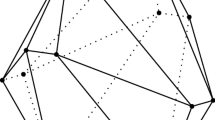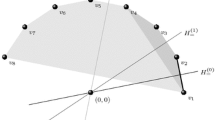Abstract
Given a finite setX and a family of “feasible” subsetsF ofX, the 0–1 polytope P (F is defined as the convex hull of all the characteristic vectors of members ofF We show that under a certain assumption a special type of face ofP(F) is equivalent to the ideal polytope of some pseudo-ordered set. Examples of families satisfying the assumption are those related to the maximum stable set problem, set packing and set partitioning problems, and vertex coloring problem. Using this fact, we propose a new heuristic for such problems and give results of our preliminary computational experiments for the maximum stable set problem.
Similar content being viewed by others
References
E. Balas and W. Niehaus, “Finding large cliques by bipartite matching,” Management Science Research Report #MSSR-597, Carnegie Mellon University (1994).
E. Balas and M. Padberg, “Set partitioning: A survey,”SIAM Review 18 (1976) 710–760.
M.L. Balinski and A. Russakoff, “On the assignment polytope,”SIAM Review 16 (1974) 516–525.
V. Chvátal, “On certain polytopes associated with graphs,”Journal of Combinatorial Theory. Series B 18 (1975) 138–154.
J. Etcheberry, “Adjacent vertices in the convex hull of solutions to the set representation problem,” Departamento de Industrias, Pub. 74/23/C, Universidad de Chile (1974).
M.R. Garey and D.S. Johnson,Computers and Intractability: A Guide to the Theory of NP-Completeness (Freeman, San Francisco, CA, 1979).
M. Grötschel and O. Holland, “Solution of large-scale symmetric travelling salesman problems,”Mathematical Programming 51 (2) (1991) 141–202.
D. Hausmann,Adjacency on Polytopes in Combinatorial Optimization (Oelschlager, Gunn & Hain, Cambridge, MA, 1979).
D. Hausmann and B. Korte, “Colouring criteria for adjacency on 0–1-polyhedra,”Mathematical Programming Study 8 (1978) 106–127.
T. Matsui and S. Tamura, Private communication (1993).
T. Matsui and S. Tamura, “Adjacency on combinatorial polyhedra,”Discrete Applied Mathematics 56 (2–3) (1995) 311–321.
G.L. Nemhauser, A.H.G. Rinnooy Kan and M.J. Todd, eds.,Optimization (North-Holland, Amsterdam, 1989).
G.L. Nemhauser and L.A. Wolsey,Integer and Combinatorial Optimization (Wiley, New York, 1988).
M.W. Padberg and M.R. Rao, “The travelling salesman problem and a class of polyhedra of diameter two,”Mathematical Programming 7 (1) (1974) 32–45.
M.W. Padberg and R. Rinaldi, “A branch-and-cut algorithm for the resolution of large-scale symmetric traveling salesman problems,”SIAM Review 33 (1991) 60–100.
J. Picard, “Maximal closure of a graph and applications to combinatorial problems,”Management Science 22 (1976) 1268–1272.
M.R. Rao, “Adjacency of the traveling salesman tours and 0–1 vertices,”SIAM Journal on Applied Mathematics 30 (1976) 191–198.
A. Schrijver,Theory of Linear and Integer Programming (Wiley, New York, 1986).
Author information
Authors and Affiliations
Additional information
Supported by a JSPS Fellowship for Young Scientists.
Supported by Grant-in-Aids for Co-operative Research (06740147) of the Ministry of Education, Science and Culture.
Rights and permissions
About this article
Cite this article
Ikebe, Y.T., Tamura, A. Ideal polytopes and face structures of some combinatorial optimization problems. Mathematical Programming 71, 1–15 (1995). https://doi.org/10.1007/BF01592241
Received:
Revised:
Issue Date:
DOI: https://doi.org/10.1007/BF01592241




